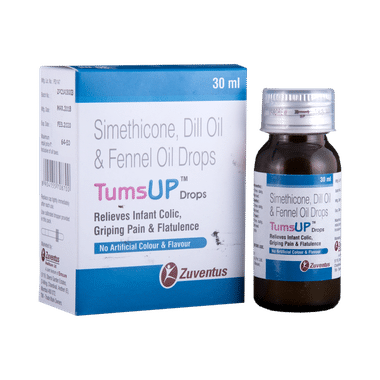

Dill Oil (0.005ml)+ Fennel Oil (0.0007ml)+ Simethicone (40mg)
Give Tumsup Drop to your child by mouth, either before or after food. Prefer giving it after food if it causes stomach upset. Usually, it is given 4 to 5 times a day after meals. But, this dosing may vary, depending upon the clinical condition, body weight, and age of your child. Do not stop this medicine abruptly by yourself as it may bring back the symptoms or worsen your child’s condition. If your child vomits within 30 minutes of the intake of this medicine, help the child calm down and repeat the dose. However, if it is already time for the next dose, do not double the dose.You must let your child’s doctor know about all the medicines your child is being given. Also, inform the doctor of any previous history of allergy, intolerance to any food products, abdominal obstruction, liver impairment, kidney malfunction, or any birth defects. This information is very important for dose alterations and for planning your child’s overall treatment.
Tumsup Drop does not pose serious side effects and is well-tolerated by children. In case the side effects do occur, they’re likely to subside once the body adapts to the medicine. Consult your child’s doctor if these side effects persist or bother your child. The most common side effects include-Common side effects of Tumsup
30 ml Drop
Image shown is a representation and may slightly vary from the actual product. Every effort is made to maintain accuracy of all information displayed.
Take this medicine in the dose and duration as advised by your doctor. Check the label for directions before use. Measure it with a marked dropper and take it as directed. Tumsup Drop is to be taken with food.
Tumsup Drop contains three active medicines: dill oil, fennel oil, and simethicone. Dill oil and fennel oil are herbal medicines that help increase the movement of the stomach and intestines, thereby making it easier to push food through the digestive system. These two ingredients also relieve muscle spasms in the gut. On the other hand, Simethicone is an antifoaming medicine that disintegrates gas bubbles and allows easy passage of gas.
Related Warnings
Tumsup Drop is safe to use in patients with kidney disease. No dose adjustment of Tumsup Drop is recommended.
However, consult your child’s doctor in cases of severe kidney disease.
Tumsup Drop is safe to use in patients with liver disease. No dose adjustment of Tumsup Drop is recommended.
However, consult your child’s doctor in cases of severe kidney disease.
The above-mentioned symptoms may indicate migraine in a child. It is characterized by recurrent episodes of dull abdominal pain which is moderate to severe in intensity. Such abdominal pain is usually accompanied by anorexia, nausea, vomiting, headache, photophobia, and pallor. Do rule out such types of pain before giving Tumsup Drop.
The doctor may advise abdominal ultrasound for a routine examination. In serious abdominal conditions, endoscopy and esophageal pH may also be monitored.
Avoid giving Tumsup Drop in obstructive and inflammatory diseases of the digestive tract as Tumsup Drop is mainly eliminated from the body through stools and its elimination will be reduced in such kinds of diseases.
Tumsup Drop should be stored at room temperature, in a dry place, away from direct heat and light. Also, keep all medicines out of the reach and sight of children to avoid any accidental intake.